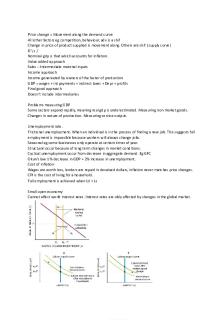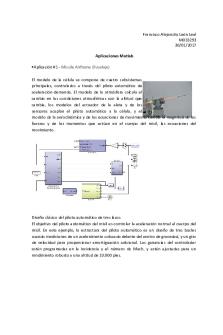M P - Simulación de Matlab PDF

| Title | M P - Simulación de Matlab |
|---|---|
| Author | Marco Rd |
| Course | Probabilidad |
| Institution | Instituto Tecnológico Autonómo de México |
| Pages | 5 |
| File Size | 219 KB |
| File Type | |
| Total Downloads | 52 |
| Total Views | 121 |
Summary
Simulación de Matlab...
Description
1. (a) Write a Matlab function that simulates the random experiment of throwing a red and green die. The output of your function should be a vector with two elements, the first of which is the number of dots on the top of the red die and the second element is the number of dots on the top of the green die. Solution: function [R] = dies(numberOfThrows) red = randi(6, numberOfThrows, 1); green = randi(6, numberOfThrows,1); red_output = sum(red); green_output = sum(green); R = [red_output, green_output]; end
(b) Use the function you wrote in part (a) to simulate 10,000 times the random experiment of throwing two dice and summing the number of dots on the top of the two dice. Use the Matlab function hist to make a histogram. Comment on the relationship between the histogram, the long-term relative frequencies, and the theoretically calculated probabilities. Solution: histogram = zeros(numberOfThrows*12, 1); numberOfExperiments = 10000; for rolls = 1 : numberOfExperiments sumOfPoints=sum(dies(1)); histogram(sumOfPoints) = histogram(sumOfPoints) + 1; end bar(histogram); grid on; caption = sprintf('Results of %d Experiments', ... numberOfExperiments); title(caption, 'FontSize', 13); caption = sprintf('Sum of Points'); xlabel(caption, 'FontSize', 20); ylabel('Count', 'FontSize', 20);
1
The histogram reflects the fact that as the number of experiments grows large, the histogram for the sum of two 6-sided dice approaches a triangle. Indeed, the mode of the distribution is the number 7. This behaviour is consistent with the theoretical distribution \[P(X=x) = \begin{cases} \frac{6-|x-7|}{36} \text{ for } x \in \left\{2,...,12 \right\} \\ 0 \text{ otherwise. }\end{cases} \] 1. (a) Write a Matlab function to simulate the random experiment of having n people in a room and observing their birthdays (month and day, not the year). You may assume that people born on February 29th report their birthday as being on March 1st. Solution: %The number represents the day of the year function birthdays = birthdays(n) birthdays = randi(365, n, 1); end
(b) Encode outcomes from the random experiment simulated in part (a) with 0 if there are no shared birthdays and 1 if at least two people share a birthday. Let p be the probability that at least two people in the room share a birthday. Use your simulation written in part (a) (and the relationship between long term relative frequency and probability) to estimate p for the 2
case n = 5, 10, 20, 23, 30, 40, and 60 and compare your estimates for p with the theoretical values for p derived in class. Solution: n_room=[5 10 20 23 30 40 60]; N=100000; p_l=length(n_room); probs=zeros(p_l,1); for c = 1:p_l A=zeros(N,1); for r = 1:N counts = histc(birthdays(n_room(c)), 1:365); if max(counts) >=2 A(r,1)=1; endif end probs(c,1)=sum(A)/N; end probs
n
Estimated probability
Theoretical probability
5
0.027020
0.027
10
0.117400
0.117
20
0.413640
0.411
23
0.507640
0.507
30
0.706820
0.706
40
0.890160
0.891
60
0.994110
0.994
1. This class has been contracted by the California Lottery Commission to write the code that chooses the 5 numbers and the mega number for the Super Lotto Plus game. They will run your code every Wednesday and Saturday to determine what that night's winning numbers will be. a. Write a Matlab function the input to your code is a positive integer, n, which is the number of groups of 5 winning numbers plus a mega number they want your code to produce, and the output should be an n x 6 array, each row being a particular choice of 5 winning numbers plus a mega number (column 6 contains the mega numbers). The following links may be of some help to you: https://www.calottery.com/play/draw-games/superlotto-plus https://www.calottery.com/play/draw-games/superlotto-plus/how-to-play
3
The function statement for your code should be function [WinningNumbers] = SuperLottoPlus (n), where WinningNumbers is an n x 6 array and n is a positive integer. Solution: function [Winning_Numbers] = Super_Lotto_Plus (n) Winning_Numbers = zeros(n,6); for r=1:n Winning_Numbers(r,1:5) = randperm(47,5,1); end for c=1:n Winning_Numbers(c,6) = randi(27,1,1); end end
a. Read the New York Times Magazine article at the link: https://www.nytimes.com/interactive/2018/05/03/magazine/money-issue-iowa-lottery-fraudmystery.html a. To see if your code is vulnerable to the same hack as the one discussed in the NYT Sunday Magazine article, see if you can surreptitiously insert some code into the function you wrote in part (a) so that you, and only you, will know what the winning numbers will be before they run the program for the drawing on Saturday November 24th, 2020. Note that the lottery commission has smart people working for them and that they will look at your code to make sure that the numbers have not simply and explicitly been chosen by you, and that your code does make use of the rand function. However, they are not nearly as familiar with Matlab and coding in general as Rosen's students are (or have been taught nearly as well as they have!), so it is possible to fool them. (Hint: It will be of some help to you to take a look at the Matlab help files for the function rand and for the functions date and datenum. Also in the Matlab command window type date and hit enter, then type datenum(date) and hit enter, then type datenum('19-Nov-2020') and hit enter, then type datenum('20-Nov-2020') and hit enter, then type datenum('21-Nov-2020') and hit enter, and by then you should get the idea!) Solution: In order to avoid the hack, one can use this variant of the wrote code in part (a): function [Winning_Numbers] = Super_Lotto_Plus (n) Winning_Numbers = zeros(n,6); for r=1:n rng(sum(100*clock)); Winning_Numbers(r,1:5) = randperm(47,5); end for c=1:n rng(sum(100*clock)); Winning_Numbers(c,6) = randi(27,1,1); end end
The line rng(sum(100*clock)) changes the random number generator for the randi function in every iteration. 4
b. You have been told that sometimes the lottery commission will run your code asking for up to, but no more than, 10 groups of winning numbers before they select one of the groups from the (up to 10) produced by your code to be that day's winning numbers plus the mega number. Under these circumstances one cannot of course predict with certainty what the winning numbers and the mega number will be. So instead, produce a list of 10 groups of 5 winning numbers plus a mega number that we could then send with Keenan to the 7-11 and tell them to buy a lottery ticket for each of the 10 groups so that it is certain that they have a winning ticket. Solution: Winning numbers
Mega
34 30 20 15 6
8
44 33 30 1 14
24
14 18 17 1 38
16
36 6 14 18 29
26
38 31 11 17 45
6
40 32 33 39 27
15
16 23 12 19 5
16
32 7 25 13 3
18
20 5 17 11 40
25
44 3 9 29 2
16
5...
Similar Free PDFs

M P - Simulación de Matlab
- 5 Pages

M. P. Accommodation Act
- 34 Pages

E X A M P L E
- 19 Pages

Tugas Kuliah - MKL - M Arfan P
- 4 Pages

Tratado de oshun[ - nm m m m
- 35 Pages

Palabras con m antes de p o b
- 5 Pages

Macro notes - m m m m m m m m m
- 2 Pages

Aplicaciones de matlab
- 6 Pages

MATLAB
- 2 Pages

Graficas-Matlab - Resuemenes Matlab
- 24 Pages
Popular Institutions
- Tinajero National High School - Annex
- Politeknik Caltex Riau
- Yokohama City University
- SGT University
- University of Al-Qadisiyah
- Divine Word College of Vigan
- Techniek College Rotterdam
- Universidade de Santiago
- Universiti Teknologi MARA Cawangan Johor Kampus Pasir Gudang
- Poltekkes Kemenkes Yogyakarta
- Baguio City National High School
- Colegio san marcos
- preparatoria uno
- Centro de Bachillerato Tecnológico Industrial y de Servicios No. 107
- Dalian Maritime University
- Quang Trung Secondary School
- Colegio Tecnológico en Informática
- Corporación Regional de Educación Superior
- Grupo CEDVA
- Dar Al Uloom University
- Centro de Estudios Preuniversitarios de la Universidad Nacional de Ingeniería
- 上智大学
- Aakash International School, Nuna Majara
- San Felipe Neri Catholic School
- Kang Chiao International School - New Taipei City
- Misamis Occidental National High School
- Institución Educativa Escuela Normal Juan Ladrilleros
- Kolehiyo ng Pantukan
- Batanes State College
- Instituto Continental
- Sekolah Menengah Kejuruan Kesehatan Kaltara (Tarakan)
- Colegio de La Inmaculada Concepcion - Cebu

![[P][W] M. Der. Martínez, Valentín Tomás](https://pdfedu.com/img/crop/172x258/70385y6g6v3e.jpg)



